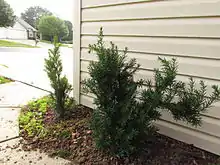Taxus × media
Taxus × media, more commonly known as the Anglojap yew[1] or simply Taxus media, is a conifer (more specifically, a yew) created by the hybridization of yew species Taxus baccata and Taxus cuspidata. This hybridization was thought to have been performed by the Massachusetts-based horticulturalist T.D. Hatfield in the early 1900s.[2]
| Taxus × media | |
|---|---|
 | |
| Two immature Taxus media (Anglojap) var. hicksii yews planted in central Indiana, United States of America. Although T. media are slow-growing, the specimen on the right may require pruning within 2-3 years in order to avoid blocking the nearby sidewalk. | |
| Scientific classification | |
| Kingdom: | Plantae |
| Clade: | Tracheophytes |
| Division: | Pinophyta |
| Class: | Pinopsida |
| Order: | Pinales |
| Family: | Taxaceae |
| Genus: | Taxus |
| Species: | T. × media |
| Binomial name | |
| Taxus × media Rehder | |
Taxonomy and common naming
The common name Anglojap is a portmanteau stemming from the national origin of T. baccata (a species native to England) and the national origin of T. cuspidata (a species native to Japan).[1]
Description
Like most yew species, T. × media prefers well-drained and well-watered soils, but has some degree of drought tolerance and in fact may die in conditions of excessive precipitation if the soil beneath the plant is not sufficiently well-drained.[1]
Taxus × media is among the smallest extant species in the genus Taxus and (depending upon cultivar) may not even grow to the size of what one would consider a typical tree. Immature shrubs are very small and achieve (over the time span of ten to twenty years) heights of at most 20 ft (6.1 m) and diameters of at most 8 ft (2.4 m), depending on the cultivar.[2] Furthermore, T. × media is known to grow rather slowly and is not injured by frequent pruning, making this hybrid very desirable as a hedge in low-maintenance landscaping and also a good candidate for bonsai.[1]
Toxicity
Taxus × media also shares with its fellow yew trees a high level of taxine in its branches, needles, and seeds. Taxine is toxic to the mammalian heart.[3]
Varieties (Cultivars)
- Taxus × media var. hicksii (also known by the common name Hicks's yew or alternately, Hicks yew) is a common cultivar of this hybrid, and is the tallest and thinnest variety of T. × media, limiting itself to a 4 ft (1.2 m) diameter, despite the fact it can achieve a height of close to 20 ft (6.1 m).[2][4]
- Another commonly-planted cultivar of T. × media is the broader-spreading densiformis version, which can reach a diameter exceeding 10 feet; nonetheless, this cultivar does not grow much past 5 ft (1.5 m) in height.[2]
| Wikimedia Commons has media related to Taxus × media. |
References
- The Ohio State University Plant Facts: Anglojap Yew
- University of Connecticut Horticulture: Taxus Media
- Wilson, C. R.; Sauer, J.; Hooser, S. B. (2001). "Taxines: A review of the mechanism and toxicity of yew (Taxus spp.) alkaloids". Toxicon. 39 (2–3): 175–85. doi:10.1016/s0041-0101(00)00146-x. PMID 10978734.
- University of Illinois - Selecting Shrubs for Your Home